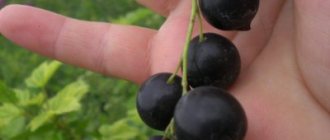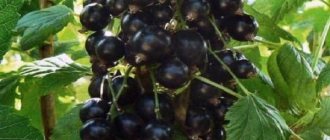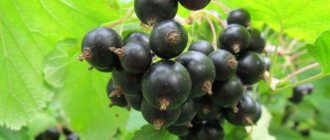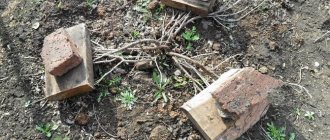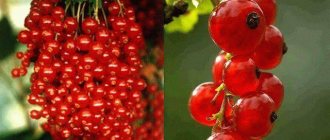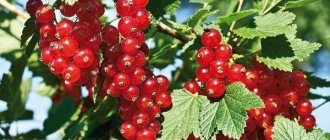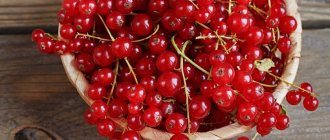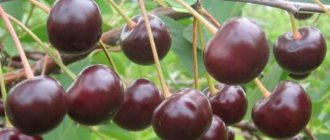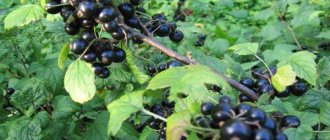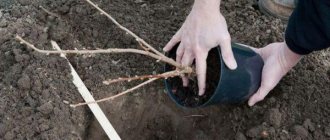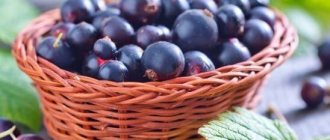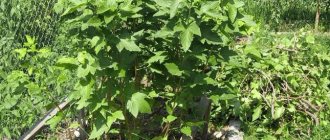Description of the currant variety Golubka
The Golubka currant variety is intended for cultivation in the middle zone, the Urals and Siberia. It looks like a medium-sized, slightly spreading bush. Its shoots are thin, erect, and fawn in color. Young branches are green. The buds are medium in size, egg-shaped, with a pointed tip, yellow-brown in color.
The leaves of the Golubka currant are five-lobed, wrinkled, and medium in size. The leaf blade is shiny, dark green, with wavy edges. The blades are pronounced and pointed. The petioles are short, green, located at an acute angle to the shoots.
The flowers are glass-shaped and medium sized. Sepals are light green, curved. The brushes are medium-sized, thick, 6 cm long. They contain from 6 to 9 fruits. Black currant berries contain dry substances, pectin, and ascorbic acid. The total sugar content is from 6.6 to 13%.
Description of Golubka currant berries:
- black thin skin with a pale coating;
- spherical shape with edges;
- weight from 1.3 to 3.5 g;
- average number of achenes;
- sweet taste with sour notes.
Description
Natalie is distinguished by good yield, tasty berries, and increased resistance to pests and diseases. It belongs to the varieties of medium ripening period, the fruiting of which occurs approximately in mid-July.
Grows well in the middle climate zone, does not tolerate drought and excess moisture. Feels best in light loam soil. He loves organic fertilizers, such as humus. It is difficult to take root and grow in soil with high acidity. In this case, mandatory liming is required.
Since the variety is self-fertile, it produces a stable annual harvest. Berries of the Natalie variety are universally used, that is, they are suitable for various types of processing: boiling, drying or freezing
It is important to harvest on time, because overripe berries lose many of their unique nutrients and vitamins.
| View | red |
| 4,4 / 5 | |
| 0.8-1 g | |
| 9 kg |
| Term | average |
| 4,4 / 5 | |
| -30°С | |
| strong |
Features of the Natalie variety
The bush is dense, medium spreading, the shoots reach 2 meters in length. The green shoots are topped with a "redness" at the tip. Lignified shoots are of medium thickness and have no edge. The buds are large, slightly oblong, solitary, the yield is distributed along the entire length of the shoot; The leaves are five-lobed, medium in size, leathery to the touch, wrinkled, without edges. The color is matte, green with a slight blue tint. At the tops of the shoots, the leaves have a curved shape. The edges are jagged; the brushes are green, medium long (7-9 cm including petiole) and thick. There is an edge on the surface; The root system is powerful, well developed, and goes deep into the earth. Thanks to this, the plant rarely suffers from lack of water; The berries are large, weighing on average 0.8 - 1 gram. They are round in shape, with a barely noticeable elongation at the base, and have a bright red rich color. Seeds of medium size, in small quantities; Compared to black currants, its red variety produces harder berries that tolerate storage and transportation better
Despite this, it is important to follow one rule: store and transport berries in small containers. If the container is too deep, there is a risk of crushing the bottom layer of currants; The variety has good winter hardiness.
Characteristics
Before planting Golubka currants, their characteristics are analyzed: resistance to drought and cold, ripening time. Particular attention is paid to the yield and quality of berries.
Drought resistance, frost resistance
Black currant Dove tolerates heat and lack of moisture well. Its frost resistance is average, about -26 °C. In harsh winters, the shoots freeze at the base. In cold climates, preparation for wintering is mandatory.
Productivity of the variety
Golubka currants ripen early. The first berries are harvested in mid-late June. They mature at the same time. Ripe currants begin to crumble and crack, so it is not recommended to delay harvesting. At the same time, the fruits of the bush do not bake in the sun.
According to the description of the variety, the black currant Golubka bears from 5 to 8 kg of berries. The plant is self-fertile and does not need a pollinator to form ovaries. Over time, the fruits become smaller. In this case, the bush should be replaced.
Application area
The berries of the Golubka variety have a technical purpose. They are used for processing: making preserves, jams, compotes, and baking fillings. Fresh berries are added to smoothies, yoghurts, and muesli.
Important! Fruit separation is wet, so the crop does not tolerate long-term storage and transportation. Berries should be used immediately after picking.
Pros and cons of the variety
According to the description of the variety and reviews, Golubka currant has the following advantages:
- brings harvest one of the first, compared to other varieties;
- self-fertility;
- begins to bear fruit early;
- demonstrates simultaneous ripening of fruits;
- stable yield;
- resistance to diseases.
The main disadvantages of the Golubka variety:
- inferior to modern varieties in taste and transportability of fruits;
- average winter hardiness;
- over time, the quality of the crop decreases;
- suffers greatly from a kidney mite attack.
Advantages and disadvantages of the variety
- Reviews from gardeners who grow Dove Seedlings indicate that the culture has a lot of positive qualities, including:
- self-fertility of the bush, which is about 80%;
- high yield rates;
- early ripening;
- good taste of fruits and their universal use;
- low maintenance requirements;
- good resistance to anthracnose and terry;
- long fruiting period.
- The culture is not without some disadvantages:
- average winter hardiness;
- low immunity to powdery mildew and bud mites;
- poor keeping quality and transportability of berries;
- the dependence of the taste of fruits on climatic conditions - the more moisture, the more sour the berries.
Reproduction methods
Black currants are propagated vegetatively:
- By cuttings. Select annual shoots with a thickness of 7 mm and cut them to a length of 20 cm. They are harvested in the fall in October, when the bush goes into a dormant state. The cuttings are rooted in a mixture of sand and soil. In spring, currants are planted in the garden, watered and fed.
- By layering. In early spring, choose a strong branch. It is placed in a pre-dug furrow, secured with staples and covered with earth. By autumn, the cuttings will have a root system, and they will be planted in a permanent place.
- Dividing the bush. The method is used when transplanting black currants. The rhizome is divided into parts, the cut is treated with wood ash. The resulting seedling should have several shoots and roots.
Seedling care
Caring for currants includes regular watering, fertilizing, loosening the soil, pruning and mulching.
Trimming
The yield of the bush and the taste characteristics of the berries depend on the correct pruning and garter. If you apply fertilizers and water the plants, but they do not produce abundant harvests, the problem is in the formation. The procedure is carried out in spring. If the branches begin to grow inward, they are removed, as this negatively affects fertility indicators. When the basal shoots stop growing, several branches are shortened by about a third. If the procedure does not give the required results, cut a few of the weakest branches to the ground. Read about pruning red and white currants here.
To restore balance between the above-ground part of the plant and the roots, new basal shoots are removed from the soil during pruning.
An adult Golubka bush should have no more than 15 shoots; cut off all old stems, as they still do not bear fruit. The shoots can be removed at the root. Spring pruning is done taking into account the results of last year's growth. If the shoot is very weak, cut off only the top of the branch in the place where the strong top is located.
Watering
Currant bushes should be watered regularly, especially if the weather is windy and dry.
Water in the evening - this way the moisture will penetrate better to the roots. A couple of buckets of water is enough for an adult bush. Water should not get into the center of the bush, since it penetrates into the gaps of the stems, freezes during cold weather and causes the death of the plant. Apply moisture around the crown; it is convenient to make a small hole around the perimeter of the bush.
Abundant watering is done until the ovaries appear on the plant.
When the ovaries form, hydration is suspended - excess water negatively affects the taste characteristics of the fruit and causes cracks to appear on them. After watering the soil, it is recommended to loosen the soil with moss, peat, newspapers, and agrofibre.
Hemlines
A good harvest is impossible without regular high-quality fertilizing. In the active growth phase, the currant variety needs mineral and organic nutrients, which are added so that the radius of the fertilized soil is greater than the radius of the crown. It is recommended to apply nitrogen fertilizers in the spring, and phosphorus and potassium fertilizers in the fall. The bushes are fed annually. Regular, but not excessive feeding is important - excess nutrients cause various crop diseases. Focuses on the gardening work calendar.
Shelter for the winter
As frost sets in and snow falls, you need to proceed to the next stage of caring for currant bushes - covering them for the winter. The branches and trunks are first wrapped with twine, try to place them as close to each other as possible. You should also not excessively connect parts of the plant, since the fragile branches of the shoots may break. Tilt the bush towards the ground, wrap it in a spiral. Cover it with a wooden box, an old blanket, a box, or spruce branches. Snow can also be used as insulation, the problem is that it does not always fall in sufficient quantities. Read about preparing currants for winter here.
Planting and care
Black currant Golubka can be planted throughout the summer season. However, it is best to choose the autumn period, when the leaves have fallen. Then the plant will have time to take root before winter and begin to develop in the spring. This option is suitable for the southern regions.
It is possible to postpone work until spring. Then the planting of black currants is carried out before the buds open. Spring work is preferable for the middle zone and northern regions. For the winter, seedlings can be buried in the ground and sprinkled with sawdust.
Black currant Dove prefers fertile, light soil. The optimal soil reaction is neutral or slightly acidic. For the bush, choose an illuminated area located on the south or west side.
A place for black currants is prepared in the fall. The soil is dug up, 1 sq. m add up to 7 kg of humus, 1 liter of ash, 100 g of superphosphate. It is best to plant several types of blackcurrants. Although the Golubka variety is self-fertile, the presence of pollinators will help increase yield. Leave 1 - 1.5 m between bushes.
Two-year-old plants are chosen for planting. They are first inspected to detect cracks, rotten areas and other defects. The seedling should have 1 - 2 shoots up to 40 cm long, strong roots. If the root system is overdried, it is immersed in clean water for 2 - 3 hours.
Procedure for planting black currant Dove:
- A hole is dug at the site with a depth of 0.6 m and a diameter of 0.5 m.
- The pit is filled 2/3 with a substrate consisting of fertile soil, 4 kg of humus, 50 g of superphosphate, and a handful of ash.
- 5 liters of water are poured into the hole and left for 3 weeks to shrink.
- Before planting, fertile soil is poured into the pit to create a small hill.
- A currant seedling is placed on top, its roots are straightened and covered with earth.
- The soil is compacted and well watered.
- The shoots are cut off, leaving 2-3 buds on each.
- A mulching layer 5 cm thick is made in the tree trunk circle. Humus or straw is used.
Aftercare
The Golubka variety grows quickly. Therefore, pruning the shoots becomes an obligatory step. It is carried out until the kidneys swell. The growing season of the bush begins very early, so it is important not to miss the pruning time. Be sure to remove broken, dry, old, diseased branches.
Advice! Autumn pruning of currants is allowed after leaf fall has passed.
For mature currants, formative pruning is performed. 3 - 5 strong branches are left per bush. The root shoots are cut out. In July, skeletal shoots are pinched. These stimulate the growth of fruit buds.
Regular watering of the Golubka variety will ensure a good harvest. Moisture is important during flowering and ovary formation. 20 liters of warm, settled water are poured under the bush. First make furrows 10 cm deep at a distance of 30 cm from the plant.
Fertilizing of the Golubka variety begins the next season after planting. In the spring, 40 g of urea is added under the bush until sap flow begins. For adult plants, the dosage is reduced to 20 g. After flowering, the currants are fed with superphosphate and potassium salt. Add 30 g of each fertilizer to 10 liters of water.
According to the description, the Golubka currant freezes slightly in harsh winters. In late autumn, the bush is hilled up, and a layer of humus is poured on top. To prevent the plant from being damaged by rodents, install a metal mesh. Young bushes are covered with non-woven fabric.
Landing technology
To get a good harvest, you should strictly follow the recommendations of experienced gardeners.
Selecting a location
Bushes are allowed to be planted freely and more densely. In the first case, the interval between plants is 1.5 meters, in the second - 70 centimeters. The closer the bushes are located, the faster they bear fruit. However, with this method of planting, they live less and produce a more modest harvest.
The culture is considered moisture-loving and shade-tolerant. However, the plant can hardly tolerate severe shading and marshy soil. Therefore, it is recommended to give preference to well-lit areas that are protected from the sun. An excellent solution would be moist areas located in lowlands.
As for the type of soil, you should give preference to light, fertile loam. Currants of this variety have difficulty with heavy soil.
Timing of planting work
Seedlings that have bare roots can be planted in autumn or spring. In this case, the first option is considered more preferable. In the middle zone, planting work can be carried out in early October. In the south, currants are planted a little later, in the north - a little earlier.
Over the winter, the soil around young bushes will become denser and settle. After this, the plants will develop more actively in the spring and take root more easily. If you plan to use container plants, there are no restrictions on planting dates.
Preparing the bed and planting hole
First, the ground on the site needs to be leveled. There should be no indentations on it. It is recommended to dig up the soil using a spade and get rid of the weed roots. The holes should be prepared in advance or right before planting.
See also
Description of blood-red currant varieties, planting and care rulesRead
The planting hole should be 50-60 centimeters in diameter. Deepen the hole by 35-40 centimeters. After preparing the hole, it is recommended to fill it 3/4 with fertile soil and fertilizers.
Selection of seedlings
It is worth purchasing seedlings in nurseries or specialized stores. One- or two-year-old bushes take root faster. Older plants have difficulty rooting and may not produce a crop.
It is important to ensure that the roots do not dry out. When transporting, the plant should be wrapped in a damp cloth. If there is any suspicion of weakness of the bush or the presence of diseases, it is better to refuse the purchase.
Step-by-step instructions for planting a seedling
Affected and dried roots need to be shortened, and the seedling should be deepened 8 centimeters above the root collar. Deepening allows the formation of root buds. They will subsequently grow into a multi-stemmed shrub.
Before filling the hole, you need to pour half a bucket of water into it. The same amount is added to the ring hole after planting the plant. After which it is recommended to loosen it and mulch with peat.
Pests and diseases
The Golubka variety is characterized by resistance to anthracnose, blight, and powdery mildew. Signs of disease appear more often in cold and rainy summers. To combat lesions, Bordeaux mixture, copper oxychloride, and the drugs Topaz, Oxychom, and Fitosporin are used.
Advice! The use of chemicals is stopped 3 weeks before the harvest ripens.
Currants of the Golubka variety are defeated by the attack of the bud mite. This is a microscopic pest that is difficult to detect visually. It feeds on currant buds, which become deformed and increase in size. It is better to fight the kidney mite with the help of the drugs Contos, Phosfamide, Actellik.
For prevention, black currants are treated with Nitrafen. Spraying is carried out until the buds swell. Digging up the soil in the fall, removing fallen leaves, and regularly pruning shoots helps get rid of pests.
Currants: choosing a variety (video)
It is necessary to water the currants until the ovaries appear on the plant. In this case, excessive moisture worsens the taste of the berries and leads to their cracking.
Loosening the soil plays a significant role in caring for currants. The soil under the bush should always be in a loose state. In spring, the soil can be mulched. To do this, you can use peat or moss.
In some cases, the soil is mulched with newspapers. And this has its advantages. During the period of formation of the green cone and separation of the buds, the newspaper will not allow insect pests to leave the soil after wintering, and it also prevents the evaporation of moisture. But during the flowering period, newspapers need to be removed. Instead of newspaper, you can lay a special covering material made of agrofibre.
The key to a good harvest is high-quality and timely fertilizing of the soil.
During the period of active growth of shoots, black currant variety Golubka needs nutrients. Top dressing can be either mineral or organic. It is necessary to apply fertilizer in such a way that the radius of the soil to be fertilized is slightly larger than the radius of the crown. In the spring it is best to fertilize currants with nitrogen fertilizers, and in the fall with potassium or phosphorus fertilizers. It is necessary to feed the bushes every year.
Characteristics of the variety
The black currant variety Perun is a medium-ripening crop that produces fruits from the end of July to mid-August.
Important! All characteristics and descriptions of this variety indicate, first of all, three main things for currants: late harvest, medium growth and spreading. The bushes are not very tall, but have a medium spreading appearance, arching shoots with dense green foliage. New young shoots are light greenish in color and bend slightly to the ground
The leaves of this variety are traditionally three-lobed with a wrinkled structure. In early spring, slightly colored buds appear on the shoots, which are covered with light down. A pleasant feature of Perun currants is self-pollination. To obtain a harvest, you do not need to plant other types of crops nearby
New young shoots are light greenish in color and bend slightly to the ground. The leaves of this variety are traditionally three-lobed with a wrinkled structure. In early spring, slightly colored buds appear on the shoots, which are covered with light down. A pleasant feature of Perun currants is self-pollination. To obtain a harvest, you do not need to plant other types of crops nearby
The bushes are not very tall, but have a medium spreading appearance, arching shoots with dense green foliage. New young shoots are light greenish in color and bend slightly to the ground. The leaves of this variety are traditionally three-lobed with a wrinkled structure. In early spring, slightly colored buds appear on the shoots, which are covered with light down. A pleasant feature of Perun currants is self-pollination. To obtain a harvest, you do not need to plant other types of crops nearby.
Unlike other varieties, bright red-violet flowers appear on the inflorescences, visible from afar.
Currant Perun
Up to 11 large berries are formed on each brush. The weight of one reaches 3-4 grams. The peel is black, bright and thin. The berries of this variety are distinguished by their good presentation: regular rounded shape, large size; when harvested, the fruits are easily torn off and are not damaged.
The taste of the berries received a score of 4.9 out of the existing 5. The pronounced currant aroma is harmoniously complemented by a sweet taste. This makes the berries universal in purpose: they are enjoyed raw, canned, frozen, and dried.
When describing the Perun currant variety, it is necessary to indicate the cultivation characteristics and suitable climatic conditions. This variety is characterized by high frost resistance. Even in the spring, with a short-term drop in temperature, the inflorescences do not fall off; temperature changes do not affect the subsequent harvest. When growing, shelter is not required if the temperature drop does not exceed -25 ° C.
The berries are quite strong, so the harvest of this variety is perfectly transported and stored raw. The yield is approximately 2-3 kg per bush.
High yield
Care
The dove needs regular (once a year) foliar feeding during the appearance of flowers and during the formation of ovaries. Both pests and fungal infections may be interested in currants, so periodic prevention of bushes with spraying is necessary.
Watering
Water the berries in the evenings to ensure better hydration of the root system. For an adult bush you will need 1.5-2 buckets. The liquid should not sit idle in the center of the plant, as it can penetrate into the stem gaps, freeze in winter and affect the harvest. Moisture is required around the crowns.
When the ovary sets, hydration stops - excess moisture will affect the taste of the fruit and form cracks. After the soil is watered, loosening is carried out using moss, peat, newspapers, and agrofibre.
Pruning and shaping the bush
Proper pruning affects the plant's yield and taste. If the gardener applies fertilizers and waters, there is no guarantee of a good harvest if an error is made in the formation. The pruning procedure is carried out in April. When branches grow inward, they are removed so that there is no negative impact on fertility. After the growth of root shoots stops, up to five branches are shortened to a third. If the procedure does not produce the required result, the weakest branches near the ground are cut off.
Top dressing
A good harvest cannot be achieved if you do not fertilize regularly. With the active development of currants, mineral and organic fertilizer should be introduced. It is recommended to apply nitrogen fertilizers in early April, and phosphorus and potassium fertilizers in October. Shrubs should be fed every year. After two years of rest, when the first replenishment was made, the procedure is repeated. Nutrients in excess cause berry diseases.
According to how frosts set in and snow falls, they begin the next step in caring for the currant plant - covering it. This procedure is also carried out for Natalie’s red currants. Branches with trunks are wrapped with twine close to each other. Excessive joining of plant parts is undesirable, as damage to fragile branches and shoots may occur. The bush bends towards the ground and wraps itself in a spiral. The young plant is covered with a wooden box, an old blanket, a box, or spruce branches. Snow wrapping is also used as insulation, but this requires a sufficient amount of snow.
Harvesting and storage of crops
Do not delay harvesting - currants are stored well on the branches, but over time they can deteriorate (rot, become more watery, and so on). It is convenient to determine maturity by the outer color of the peel. The simultaneity of achieving full maturity, crumbling indicators, size, and taste are important.
Treasure currants are stored well, but if the harvest is very bountiful, it is better to immediately process some of the berries or freeze them.
Fruits last the longest in refrigerators and basements. Trays or containers are used to stack them; multi-layered stocks should not be made, since the berries will crush and crush each other.
Appearance, characteristics of berries, ripening time, yield
Yubileynaya Kopanya is a mid-late growing season variety whose fruits ripen at the end of July. The berries of the crop are quite large, weighing about 3.5–5 g, oval-round in shape, dark, almost black in color with a shiny smooth surface.
The fruits are dry cut, have a dense skin that is not prone to cracking, and are easily transported and stored. The pulp is green-brown in color, tender, very juicy, characterized by a delicate sweet and sour taste and rich aroma.
Professional tasters rated the taste of the berries very highly - 4.5 points out of a possible 5.
The berries are of high nutritional value: they contain 14.4% dry matter, 11% sugars, 2.9% acids, 1.6% pectins. The pulp contains 456 mg of phenols and 232 mg of ascorbic acid per 100 g.
The fruits ripen simultaneously and do not fall off after ripening. Plant productivity indicators are high and stable. According to reviews from experienced gardeners, one bush can produce 5–6 kg of selected berries per season.
The fruits have a universal purpose and are widely used for fresh consumption, as well as raw materials for preparing gourmet dishes, desserts, wines, juices, sauces, winter preparations, jams and preserves. Berries are great for freezing.
Familiarize yourself with the beneficial and harmful properties of black currant for the human body.
